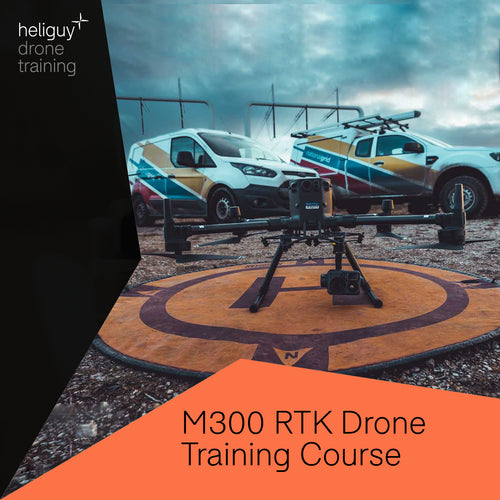heliguy™ Drone Training
Trusted by UK Emergency Services, Oil & Gas Majors and the AEC industry
heliguy™ is an industry leader in drone training.
Our in-house team of instructors - including ex-military personnel - have vast experience in multirotor and fixed-wing aircraft to empower commercial and enterprise drone operations.
They have taught more than 3,000 candidates and delivered training to the likes of Network Rail, National Grid, Balfour Beatty, London Fire Brigade, Phillips 66, PD Ports, and police forces around the UK.
Through comprehensive and wide-ranging training provision, heliguy™ offers a career pathway to allow organisations to scale their drone programmes, and individual pilots to develop their operational capabilities.
Who Trains with Us
Take a look at some of the brands and businesses who've trained with heliguy™.








CAA Approved Drone Training
heliguy™ offers a range of CAA-approved drone training courses
Regulated Qualifications
Ofqual-recognised drone training qualifications for pilots and operations managers.
Extra Skills and Additional Training
heliguy™ offer a range of added value training courses alongside CAA certifications.
Click to view the interactive training career pathway

Night Permissions

Lifetime Support

Free Resits

Facebook Group

Operations Manual Creation

Online Training
Meet the Drone Training Team
Meet the expert heliguy™ drone training team who will guide you through your certification.

- Worked with drones since 2008, including roles as a military UAV Operator and international operations of the Hermes 450 Tactical UAV.
- Logged 1500+ flying hours with fixed-wing and multi-rotor drones.
- 7 years' experience as RPAS instructor; conducting flight assessments, instructing courses, and deploying internationally.
- Former chief Remote Pilot for UK-based fixed-wing drone manufacturer.

Tom Anderson
Head of Safety, Training Instructor
- A commercial drone remote pilot, working as a full-time heliguy™ training instructor since 2016.
- Vast experience of working as an instructor: DSA Approved Driving Instructor, PADI Master Scuba Diver Trainer.
- One of the UK's first to attain Mountain Training Association Development Coach Award.
- Tom is not only a remote pilot but also designs and builds both fixed and rotary-wing aircraft.

Ben Shirley
Head of Training Development
- Former commercial drone operator, with a passion for aerial photography / videography.
- Key member of heliguy™ training team since 2017.
- 13 years in the British Armed Forces, attaining rank of Staff Sergeant and conducting international tours.
- Former Royal Military Police, bringing his knowledge of policing to the emergency service application of UAS.
- Experience of working in the TV, film and gaming industry.
Jack Sharp
Training Instructor

- Qualified drone training pilot, with GVC, A2 CofC and a PfCO.
- Recreational drone pilot since 2017, specialising in aerial photography.
- Photography work featured by the BBC, Forestry England and Mountain Warehouse.
- Vast training background, developing experience in NHS forensic section and at HM Prison Service.
Brandon Jones
Training Instructor

- Commercial drone operator, specialising in photography and cinematography and part of the heliguy™ in-house photography team. This experience will benefit candidates who are focusing on aerial content creation.
- Accumulated an extensive technical prowess operating in alpine terrain, with more than a decade of dedication to maintaining and expanding a degree of alpinist mastery, culminating in both domestic and GBR athletic representation.
- Developed extensive dexterity in coordinating and delivering in-person and remote training programmes in the outdoor pursuits sector, including climbing, skiing, and drones.
- Has developed excellent working relationships with UK-based and international clients.

Josh
OSC Specialist
- Former UAS Technical Surveyor at the CAA, responsible for the evaluation, development and approval of OSC applications.
- Well versed in the process, requirements, and best practises of building an OSC document.
- His experience will save applicants' time in creating an effective and compliant OSC and should stop the need to go through potentially costly reviews and rewrites with the CAA - saving you money in the process.

Ben Sangster
In-house GIS specialist
- Working within the sales, training and technical departments of heliguy™ in order to provide consultancy and develop educational material for our customers.
- Account manager for AEC clients such as Laing O'Rourke, Boskalis, Balfour Beatty and Komatsu, providing aerial surveying consultancy, hardware supply, and workflow support.
- Experienced with ESRI’s AcGIS & SiteScan, Pix4D, DJI Terra, Terra Solid and CAD.
- Guest speaker at 2021 Digital Construction Week in London, representing heliguy™ and Esri UK.
- Technical lead on aerial surveying, ESRI Site Scan and Zenmuse L1 training courses.
Faye Ashton
Training Administrator

- More than 10 years of experience in logistics, including former heliguy™ warehouse manager.
- Spent 7 years as an online technical advisor for HMRC.
- Served in the Royal Navy for 7 and a half years, employed in the warfare branch communications sector and reached the rank of Leading Hand.
- Served onboard HMS Cumberland, HMS Illustrious and HMS Invincible, with active service around the world, in locations such as the Gulf and Sierra Leone.
- Faye's career has helped her develop public interaction skills, understand the value of teamwork and experience different cultures.
Leon Henderson
Training Instructor

- 24 years in the British Armed Forces, with multiple operational deployments overseas.
- Was responsible for the execution of counter-surveillance and counter-insurgency operations which required the crucial support of UAS.
- Delivered UAS training for the British Armed Forces - including hardware capabilities, deployment techniques, and how to incorporate the technology into the planning and execution phases of operations.
- Experienced instructor in training and development with skills ranging from designing, implementing, and delivering a wide selection of courses and materials for both UK and overseas clients.
- Leon's experience is particularly suited to heliguy™ training candidates in the security, surveillance, and public safety sectors.
Chris Thompson
Training Instructor

- Six years of training experience for Sage as a Professional Services Consultant.
- 3D Computer Animation Degree. Chris is using his experience to design eye-catching and engaging graphics and visuals for the heliguy™ online training content, helping to benefit candidates' learning experiences.
- Was a coordinator at a 3D product visualisation platform, helping brands increase customer conversion through digital solutions. This experience helps heliguy™ training candidates who want to receive advice on ways of advancing their drone business's digital offering.
- Previous experience in the technology sector, having worked for an automotive car configurator company.
Accreditations & Awards












"The Heliguy-delivered training was fantastic. I can't recommend them enough.
Two of our officers were deployed with the drone less than 48 hours after training, filling a gap in operational capability in the process. That they had the confidence and ability to deploy so quickly after passing was due to Heliguy. If our officers had not done the course, there would not have been drone cover over that period. Having a greater number of officers trained around the Force gives us 24/7 drone capability."
PC Tom Gee
Derbyshire Constabulary
heliguy™ End to End Support
Drone training is just one part of a drone programme.
heliguy™ provides end-to-end support encompassing all aspects of a drone programme, from dynamic supply to in-house repairs & drone maintenance. This provides continuity from your drone training experience.

Free Consultancy
This comes as standard. Benefit from our vast knowledge pool, industry case studies and network of worldwide suppliers to build a tailored and appropriate solution for you.

Large Supply, Including Rental
Access our vast stock inventory, specialising in, but not confined to, DJI hardware. We also offer drone rental for dynamic scaling, one-off jobs, and proof of concept.

Logistics Network
Next-day delivery and IATA Certification to ship high-power batteries overseas; especially useful for international drone programmes. We've shipped to the U.S, Africa and the Middle East.

In-house Repairs
Utilise our in-house team of DJI-approved technicians to minimise your downtime. This includes fast-track repairs, swap-outs, fault diagnosis, and one-to-one support.

R&D Lab
heliguy™ Lab drives drone industry innovation. In-house 3D printing machines for R&D, product development/design, and rapid prototyping.

Drone Defence
Need to protect your airspace? heliguy™ Detect can help with a range of industry-leading solutions. Our drone defence clients include Gatwick Airport, the MET Police and MOD.
"Flexible and on-demand online training is available anytime, anywhere to anyone who wants it. This means that you can learn at your own pace...
heliguy™ drone training courses cover the theoretical basis required to become a specialist in aerial operations."
Fix the Photo
Photo Editing Service
 Ecosystem
Ecosystem
Expert support for life for all customers.
-
![]()
Training
CAA Permissions
-
![]()
Support
Lifetime Support
-
![]()
Repairs
DJI Repair Centre
-
![]()
heliguy™
Survey Support




































 Ecosystem
Ecosystem



